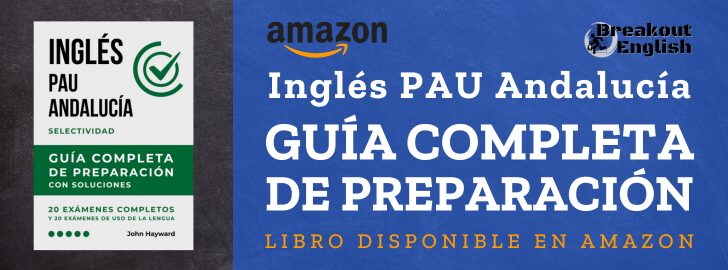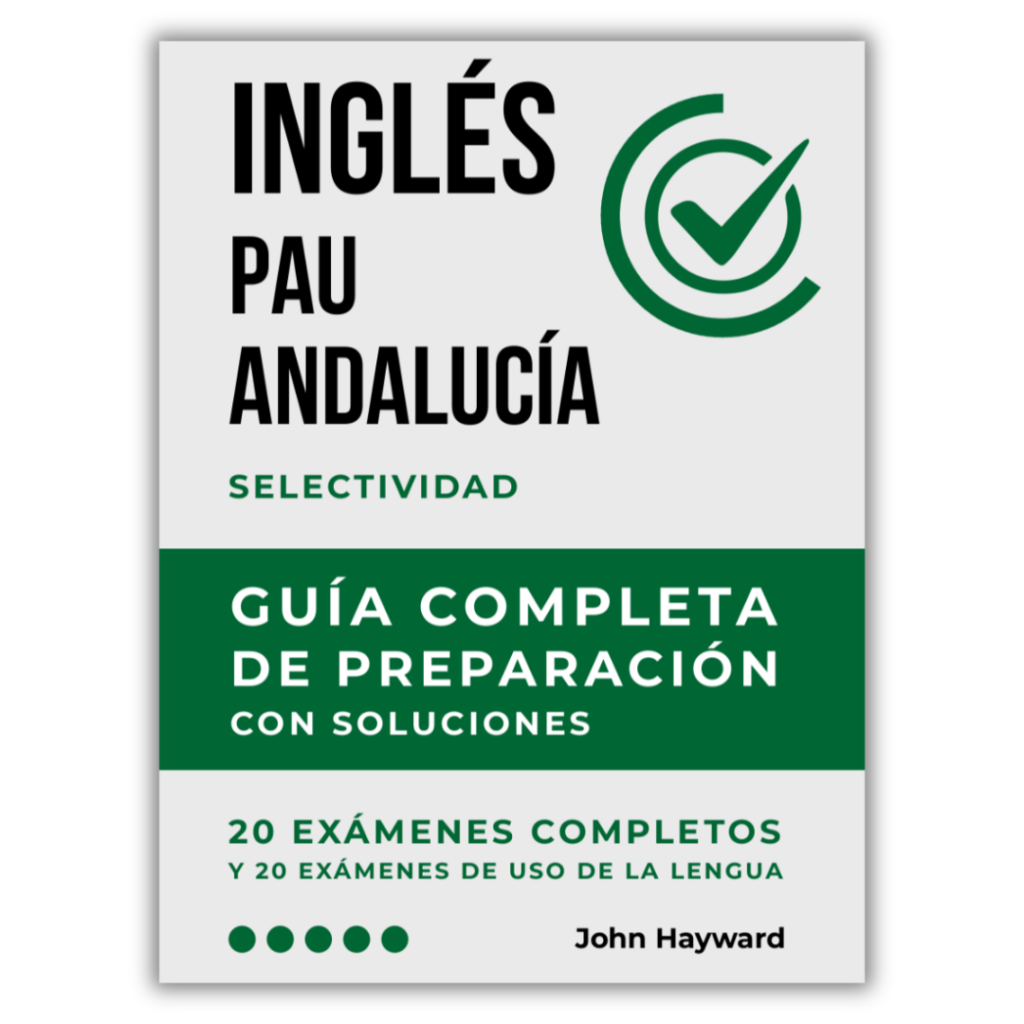I’ve guided several groups through Selectividad English, and each year brings fresh challenges and surprises. This year, the powers that be have changed the Selectividad English exam for Spanish Bachillerato students in Andalusia. These upcoming Selectividad changes in 2025 feel more relevant than ever, changing how students approach reading, grammar, and writing. Officially known as Pruebas de Acceso a la Universidad (PAU), in Andalusia, this exam is undergoing a few tweaks that impact how we teach and how students prepare.
It’s for this reason that we’ve created this book: a clear, practical and comprehensive guide to help both teachers and students face the new PAU English exam in Andalucía with confidence. Inside, you’ll find updated exam models, useful strategies and detailed explanations to guide you every step of the way.
Inglés PAU Andalucía: Guía completa de preparación con soluciones:

I once had a student who was so anxious about the grammar section that she tried to memorise an entire grammar book in two weeks. It wasn’t pretty, but we learned an important lesson together: targeted study beats mindless cramming any day. Another one was so determined to master every grammar structure that she color-coded her notes with pastels for verb tenses, neon shades for conditionals, and regular pencil for everything else. It may seem like overkill, but her notes looked like a work of modern art, and her precision improved dramatically. With the new PAU Andalucía 2025 format, a thorough organisation remains a wise strategy.

Contents
Key Changes and Structure
The updated structure ensures a balanced evaluation of essential language skills through three sections:
- Reading Comprehension (Bloque A) – Worth 4 points, this section includes a 350–400-word text followed by eight(ish) questions:
- Two multiple-choice questions (0.5 points each).
- Four true/false questions requiring precise justification from the text (0.5 points each).
- Two vocabulary-related tasks with two questions each (synonyms or definitions; 0.25 points each).
- Use of English (Bloque B) – Worth 3 points, this section assesses grammar and lexical skills. Students choose one of two sets of six questions, which includes sentence transformations and rewriting tasks.
- Writing (Bloque C) – Also worth 3 points, students must write a 120-word essay on one of two proposed topics. Essays can be narrative, argumentative, or descriptive.
Reading Comprehension
The reading comprehension section features a single text, slightly longer than the past format (350–400 words). Students tackle multiple-choice questions, true/false statements with justifications, and vocabulary tasks worth smaller point increments. There’s no second text to choose from, but this wasn’t a big factor in success for the old format, so this change doesn’t make an enormous difference. The best approach, as with improving reading skills in general, is to practice reading real-world materials. It’s worth four points and these are points that I aim for my students to always get 4/4. Anything less is rated as “needs work”.
Use of English
Grammar and lexical skills in the Use of English section in the Andalusian PAU exam are worth three points, and this section doesn’t come so easy. It is designed to evaluate students’ grammatical and lexical skills through sentence transformation tasks. Each question requires the student to rewrite a sentence while maintaining its original meaning. This new format feels like it has been modeled more closely on B2-level Cambridge key-word transformation tasks. The tasks are presented in two formats:
- Start with a given word or phrase: Students are prompted to begin the sentence with a specific phrase and complete it correctly.
- Use a provided keyword: A word is supplied, and students must incorporate it into the sentence while preserving its intended meaning.
Students pick one of two sets with six questions, and they must answer all of them, no skipping. From personal experience, the biggest stumbling block comes when students mix up simple transformations under pressure. Mistakes with verb agreement, auxiliaries, prepositions or other small details will cost you points. Keeping a calm head helps avoid confusion over common structures, especially when rewriting questions or challenging grammar like conditionals and reported speech.
Example Tasks
Here’s a closer look at the type of transformations seen in Use of English:
- “Have you ever been to Paris?” she asked me.
She asked me if…
She asked me if I had ever been to Paris. - I won’t call him unless I need his help.
(IF)
If I don’t need his help, I won’t call him. - It’s a pity they didn’t tell us the truth.
I wish…
I wish they had told us the truth. - The fire destroyed the old factory completely.
The old factory…
The old factory was completely destroyed by the fire. - John started playing the guitar five years ago.
John has…
John has been playing the guitar for five years. - She studies so hard that she always gets excellent grades.
(SUCH)
She is such a hard-working student that she always gets excellent grades.
Writing
As for writing, the Selectividad changes 2025 don’t affect the basics: one essay (120 words minimum) chosen from two options. Essays can be descriptive, argumentative, or narrative. The key here is accuracy. There are three points possible, from which you can be penalised for mistakes with grammar, vocabulary, organisation and even penmanship. Repeated grammar errors are counted only once, focusing on evaluating the student’s overall performance positively. Essays must keep to the minimum 120-word requirement and deviating from the given topic results in 0 points for the Writing section.
The Writing section is graded based on three main criteria, each worth 1 point. These are evaluated on a scale (1 / 0.75 / 0.5 / 0.25 / 0 points).
- Grammatical Accuracy:
-Correct word order (e.g., subject-verb-object agreements in affirmative sentences).
-No errors in subject-verb agreement, determiners, or pronouns.
-Proper use of tenses and their formation (e.g., past perfect, conditionals).
-Appropriate use of modal verbs and their structures.
-Accurate preposition usage and negative structures.
-Correct spelling of irregular plurals and avoidance of adjective pluralization. - Lexical Richness and Precision:
-Use of a varied and precise vocabulary.
-Appropriate choice of terms without repetition.
-Avoidance of basic word confusions (e.g., learn/teach, borrow/lend).
-Correct use of grammatical categories (e.g., distinguishing live (verb) from life (noun)).
-Avoidance of fillers or unnecessary phrases. - Textual and Communicative Features:
-Logical and clear organization of ideas.
-Division into coherent paragraphs with relevant content.
-Proper use of connectors and cohesive devices.
-Originality and adherence to the topic.
-Clean, legible presentation with correct punctuation and spelling.
-Overall demonstration of communicative ability and maturity in expressing ideas.
Grammar Topics for the 2025 PAU in Andalusia
Verb tenses and verb patterns stand out as major points in the new PAU exam in Andalusia. Passive voice, modal verbs, and comparisons come next. Structures like conditionals and reported speech might feel tricky, but they still matter, especially if a rewrite question pops up in the Use of English section. One tip: create a quick mental checklist (subject-verb agreement, correct tense, accurate word order) before finalizing each sentence.
Here’s my personal list of grammar topics ranked in order of importance:
High Priority:
- Verb Tenses
- Verb Patterns
Medium Priority:
- Passive Voice
- Modal Verbs
- Question Formation
- Comparatives
Lower Priority: (but still essential to teach)
- Wish / If Only
- Phrasal Verbs
- Relative Clauses
- Conditionals (1st, 2nd, 3rd)
- Reported Speech
- Past Modals
- Causative
- So/Such
- Too/Enough
- Pronoun Agreement
- Question Tags
- Dependent Prepositions
Practical Tips for Preparing the PAU exam in Andalusia
Reading short articles, opinion pieces, and even blog posts boosts comprehension. For grammar, daily sentence-transformations and on-the-spot rewriting drills sharpen accuracy. You have to hit the book s with the grammar for this exam, which feels old-fashioned, but it is what it is. In writing, a focused approach—drafting a clear introduction, main body, and conclusion—helps students stay organized and hit the word limit comfortably.
That’s exactly where this guide comes in: we’ve gathered practical strategies and real exam models so you don’t have to improvise or waste time looking for materials. Everything you need is right here, organised and focused on helping you get the best possible grade in the PAU exam.
Inglés PAU Andalucía: Guía completa de preparación con soluciones:

Looking Ahead
These Selectividad changes 2025 and the updated PAU Andalucía 2025 format aim for more relevant assessments, highlighting real communication skills rather than memorized knowledge. Whether or not it is successful in this attempt is up for debate, but I’d say it’s a slight improvement from the old format. From my vantage point, students who’ve trained with consistent reading practice, solid grammar drills, and structured writing tasks will be well-prepared to tackle the new exam.

